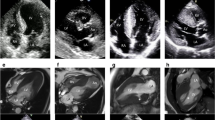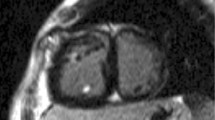Abstract
Our aim was (1) to detect the presence of fibrosis by Cardiac magnetic resonance imaging (CMR) in the pediatric age group. (2) Correlate CMR findings with demographic data, LV function, and other echocardiographic parameters. We studied 40 pediatric patients diagnosed as HCM by echocardiography. All patients were subjected to clinical examination (in which the NYHA classification was determined for each patient), echocardiography, and CMR. CMR was done on a 1.5T Philips Achieva scanner in SSFP with delayed myocardial enhancement (DE-MRI). All demographic and functional parameters as well as pressure gradient across left ventricular outflow tract (LVOT) were correlated with the percentage of myocardial enhancement. We studied 13 female and 27 male patients from 45 days up to 18 years. The mean percentage of DE-MRI was 9.7 ± 9%. We found significant correlation between the NYHA classification and the pressure gradient across the LVOT (P = < 0.001) as well as the percentage of DE-MRI (P = 0.004). The percentage of DE-MRI showed positive correlation with LV myocardial mass index (P = 0.042). It didn’t correlate with any other demographic or LV functional cardiac parameters. A good positive correlation was detected between the percentage of DE-MRI and the severity of pressure gradient across LVOT measured by echocardiography (r = 0.69 and P = <0.001). We found a significant correlation between the percentage of DE-MRI in children with HCM and the pressure gradient across LVOT, NYHA classification, and LV myocardial mass. This may help in the further management of those patients, planning for follow-up, and prognosis of the disease.





Similar content being viewed by others
References
Authors/Task Force members, Elliott PM, Anastasakis A, Borger MA et al (2014) ESC Guidelines on diagnosis and management of hypertrophic cardiomyopathy: the Task Force for the Diagnosis and Management of Hypertrophic Cardiomyopathy of the European Society of Cardiology(ESC). Eur Heart J 2014(35):2733–2779
Mahrholdt H, Wagner A, Judd RM, Sechtem U, Kim RJ (2005) Delayed enhancement cardiovascular magnetic resonance assessment of non-ischaemic cardiomyopathies. Eur Heart J 26:1461–1474
Rickers C, Wilke N, Jerosch-Herold M, Casey SA, Panse P, Panse N, Weil J, Zenovich AG, Maron BJ (2005) Utility of cardiac magnetic resonance imaging in the diagnosis of hypertrophic cardiomyopathy. Circulation 112:855–861
Maron MS, Hauser TH, Dubrow E, Horst TA, Kissinger KV, Udelson JE, Manning WJ (2007) Right ventricular involvement in hypertrophic cardiomyopathy. Am J Cardiol 100:1293–1298
Maron MS, Maron BJ, Harrigan C, Buros J, Gibson CM, Olivotto I, Biller L, Lesser JR, Udelson JE, Manning WJ, Appelbaum E (2009) Hypertrophic cardiomyopathy phenotype revisited after 50 years with cardiovascular magnetic resonance. J Am Coll Cardiol 54:220–228
Hudsmith LE, Neubauer S (2008) Detection of myocardial disorders by magnetic resonance spectroscopy. Nat Clin Pract Cardiovasc Med 5(Suppl 2):S49–S56
Sipola P, Lauerma K, Jääskeläinen P, Laakso M, Peuhkurinen K, Manninen H, Aronen HJ, Kuusisto J (2005) Cine MR imaging of myocardial contractile impairment in patients with hypertrophic cardiomyopathy attributable to Asp175Asn mutation in the alpha tropomyosin gene. Radiology 236(3):815–824
Hansen MW, Merchant N (2007) MRI of hypertrophic cardiomyopathy: part 2, differential diagnosis, risk stratification, and posttreatment MRI appearances. AJR Am J Roentgenol. 189(6):1344–1352
The Criteria Committee of the New York Heart Association (1994) Nomenclature and criteria for diagnosis of diseases of the heart and great vessels, 9th edn. Little, Brown & Co., Boston, pp 253–256
Gersh BJ, Maron BJ, Bonow RO, et al. (2011) for the American College of Cardiology Foundation/American Heart Association Task Force on Practice Guidelines (2011) ACCF/AHA guideline for the diagnosis and treatment of hypertrophic cardiomyopathy: a report of the american College of Cardiology Foundation/American Heart Association Task Force on practice guidelines. Developed in collaboration with the American Association for Thoracic Surgery, American Society of Echocardiography, American Society of Nuclear Cardiology, Heart Failure Society of America, Heart Rhythm Society, Society for Cardiovascular Angiography and Interventions, and Society of Thoracic Surgeons. J Am Coll Cardiol 58:e212–e260
Elliott P, McKenna WJ (2004) Hypertrophic cardiomyopathy. Lancet 363:1881–1891
Kwon DH, Smedira NG, Rodriguez ER, Tan C, Setser R, Thamila M et al (2009) Cardiac magnetic resonance detection of myocardial scarring in hypertrophic cardiomyopathy: correlation with histopathology and prevalence or ventricular tachycardia. J Am Coll Cardiol 54:242–249
Gerdts E, Bjornstadt H, Toft S, Devereux RB, Omvik P (2002) Impact of diastolic Doppler indices on exercise capacity in hypertensive patients with electrocardiographic left ventricular hypertrophy (a LIFE substudy). J Hypertens 20:1223–1229
Harris KM, Spirito P, Maron MS, Zenovich AG, Formisano F, Lesser JR, Mackey-Bojack S, Manning WJ, Udelson JE, Maron BJ (2006) Prevalence, clinical profile, and significance of left ventricular remodeling in the end-stage of hypertrophic cardiomyopathy. Circulation 114:216–225
Aryana A, d’Avila A, Heist EK, Mela T, Singh JP, Ruskin JN, Reddy VY (2007) Remote magnetic navigation to guide endocardial and epicardial catheter mapping of scar-related ventricular tachycardia. Circulation 115:1191–1200
Mavrogeni S, Petrou E, Kolovou G, Theodorakis G, Iliodromitis E (2013) Prediction of ventricular arrhythmias using cardiovascular magnetic resonance. Eur Heart J Cardiovasc Imaging 14(6):518–525
Moon JC, Reed E, Sheppard MN et al (2004) The histologic basis of late gadolinium enhancement cardiovascular magnetic resonance in hypertrophic cardiomyopathy. J Am Coll Cardiol 43(12):2260–2264
Dimitrow PP, Klimeczek P, Vliegenthart R et al (2008) Late hyperenhancement in gadolinium-enhance magnetic resonance imaging: comparison of hypertrophic cardiomyopathy patients with and without nonsustained ventricular tachycardia. Int J Cardiovasc Imaging 24(1):77–83
Kwon DH, Smedira NG, Rodriguez ER et al (2009) Cardiac magnetic resonance detection of myocardial scarring in hypertrophic cardiomyopathy: correlation with histopathology and prevalence of ventricular tachycardia. J Am Coll Cardiol 54(3):242–249
Nazarian S, Lima JA (2008) Cardiovascular magnetic resonance for risk stratification of arrhythmia in hypertrophic cardiomyopathy. J Am Coll Cardiol 51(14):1375–1376
O’Hanlon R, Grasso A, Roughton M, Moon JC, Clark S, Wage R, Webb J, Kulkarni M, Dawson D, Sulaibeekh L, Chandrasekaran B, Bucciarelli-Ducci C, Pasquale F, Cowie MR, McKenna WJ, Sheppard MN, Elliott PM, Pennell DJ, Prasad SK (2010) Prognostic significance of myocardial fibrosis in hypertrophic cardiomyopathy. J Am Coll Cardiol 56:867–874
Maron MS, Appelbaum E, Harrigan CJ, Buros J, Gibson CM, Hanna C, Lesser JR, Udelson JE, Manning WJ, Maron BJ (2008) Clinical Profile and Significance of delayed enhancement in Hypertrophic Cardiomyopathy. Circ Heart Fail. 1:184–191
Rubinshtein R, Glockner JF, Ommen SR, Araoz PA, Ackerman MJ, Sorajja P, Bos JM, Tajik AJ, Valeti US, Nishimura RA, Gersh BJ (2010) Characteristics and clinical significance of late gadolinium enhancement by contrast-enhanced magnetic resonance imaging in patients with hypertrophic cardiomyopathy. Circ Heart Fail. 3:51–58
Colan SD, Lipshultz SE, Lowe AM et al (2007) Epidemiology and cause-specific outcome of hypertrophic cardiomyopathy in children: findings from the Pediatric Cardiomyopathy Registry. Circulation 115:773–781
El-Saiedi SA, Seliem ZS, Esmail RI (2013) Hypertrophic cardiomyopathy: prognostic factors and survival analysis in 128 Egyptian patients. Cardiol Young 29:1–7
Choudhury L, Mahrholdt H, Wagner A et al (2002) Myocardial scarring in asymptomatic or mildly symptomatic patients with hypertrophic cardiomyopathy. J Am Coll Cardiol 40:2156–2164
Moon JC, McKenna W, McCrohon JA, Elliott PM, Smith GC, Pennell DJ (2003) Toward clinical risk assessment in hypertrophic cardiomyopathy with gadolinium cardiovascular magnetic resonance. J Am Coll Cardiol 41:1561–1567
Moon JC, Mogensen J, Elliott PM, Smith GC, Elkington AG, Prasad SK, Pennell DJ, McKenna WJ (2005) Myocardial late gadolinium enhancement cardiovascular magnetic resonance in hypertrophic cardiomyopathy caused by mutations in troponin I. Heart 91:1036–1040
Wilson JM, Villareal RP, Hariharan R, Massumi A, Muthupillai R, Flamm SD (2002) Magnetic resonance imaging of myocardial fibrosis in hypertrophic cardiomyopathy. Tex Heart Inst J 29:176–180
Teraoka K, Hirano M, Ookubo H, Sasaki K, Katsuyama H, Amino M, Abe Y, Yamashina A (2004) Delayed contrast enhancement of MRI in hypertrophic cardiomyopathy. Magn Reson Imaging 22:155–161
Noureldin RA, Liu S, Nacif MS, Judge DP, Halushka MK, Abraham TP, Ho C, Bluemke DA (2012) The diagnosis of hypertrophic cardiomyopathy by cardiovascular magnetic resonance. J Cardiovasc Magn Reson 14:17
Dumont C, Monserrat L, Soler R, Rodríguez E, Fernández X, Peteiro J, Bouzas B, Piñón P, Castro-Beirasa A (2007) Clinical significance of late gadolinium enhancement on cardiac magnetic resonance in patients with hypertrophic cardiomyopathy. Rev Esp Cardiol 60(1):15–23
Monserrat L, Elliott PM, Gimeno JR, Sharma S, Penas-Lado M, McKenna WJ (2003) Nonsustained ventricular tachycardia in hypertrophic cardiomyopathy: an independent marker of sudden death risk in young patients. J Am Coll Cardiol 42:873–879
Adabag AS, Casey SA, Kuskowski MA, Zenovich AG, Maron BJ (2005) Spectrum and prognostic significance of arrhythmias on ambulatory Holter electrocardiogram in hypertrophic cardiomyopathy. J Am Coll Cardiol 45:697–704
Funding
This study was not funded.
Author information
Authors and Affiliations
Corresponding author
Ethics declarations
Conflict of Interest
All authors declare that they have no conflict of interest.
Ethical approval
All procedures performed in studies involving human participants were in accordance with the ethical standards of the institutional and/or national research committee and with the 1964 Helsinki declaration and its later amendments or comparable ethical standards.
Informed consent
Informed consent was obtained from all individual participants included in the study.
Rights and permissions
About this article
Cite this article
El Saiedi, S., Behairy, N.H., Kharabish, A. et al. Delayed Myocardial Enhancement in Pediatric Hypertrophic Cardiomyopathy: Correlation with LV Function, Echocardiography, and Demographic Parameters. Pediatr Cardiol 38, 1024–1031 (2017). https://doi.org/10.1007/s00246-017-1612-y
Received:
Accepted:
Published:
Issue Date:
DOI: https://doi.org/10.1007/s00246-017-1612-y




